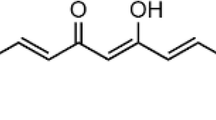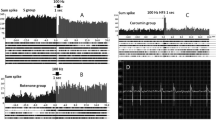Abstract
Parkinson’s disease (PD) is a debilitating neurodegenerative disorder that results from the loss of or damage to dopaminergic cells in the substantia nigra. Exposure to either the pesticide rotenone or the endogenous neurotoxin salsolinol has been shown to mimic this dopaminergic cell loss. In this study, we first sought to determine whether combination of rotenone and salsolinol would result in an additive or synergistic toxicity. For this purpose we utilized SH-SY5Y cells, a human neuroblastoma cell line that is commonly used to model dopaminergic neurodegeneration. We then tested whether curcumin, a natural plant compound with known health benefits including potential neuroprotective properties, could also protect against rotenone and/or salsolinol-induced toxicity. Moreover, since apoptotic mechanism has been implicated in toxicity of these compounds the anti-apoptotic effect of curcumin was also evaluated. Our results indicate a synergistic toxicity of low concentrations of rotenone (1 and 5 µM) and salsolinol (25 and 50 µM) that was associated with apoptosis as determined by cell flow cytometry. There was also an increase in caspase-3 levels. Pretreatment with curcumin (1–10 µM) dose-dependently attenuated rotenone and/or salsolinol-induced toxicity and the associated apoptosis. These results suggest that exposure to a combination of rotenone and salsolinol may contribute to the pathology of PD, and that curcumin has a therapeutic potential in this disease.








Similar content being viewed by others
References
Aggarwal BB, Harikumar KB (2009) Potential therapeutic effects of curcumin, the anti-inflammatory agent, against neurodegenerative, cardiovascular, pulmonary, metabolic, autoimmune and neoplastic diseases. Int J Biochem Cell Biol 41:40–59
Aggarwal BB, Sundaram C, Malani N, Ichikawa H (2007) Curcumin: the Indian solid gold. Adv Exp Med Biol 595:1–75
Alam M, Schmidt WJ (2002) Rotenone destroys dopaminergic neurons and induces parkinsonian symptoms in rats. Behav Brain Res 136:317–324
Alladi PA, Mahadevan A, Yasha TC, Raju TR, Shankar SK, Muthane U (2009) Absence of age-related changes in nigral dopaminergic neurons of Asian Indians: relevance to lower incidence of Parkinson’s disease. Neuroscience 159:236–245
Antkiewicz-Michaluk L (2002) Endogenous risk factors in Parkinson’s disease: dopamine and tetrahydroisoquinolines. Pol J Pharmacol 54:567–572
Betarbet R, Sherer TB, MacKenzie G, Garcia-Osuna M, Panov AV, Greenamyre JT (2000) Chronic systemic pesticide exposure reproduces features of Parkinson’s disease. Nat Neurosci 3:1301–1306
Bhutani MK, Bishnoi M, Kulkarni SK (2009) Anti-depressant like effect of curcumin and its combination with piperine in unpredictable chronic stress-induced behavioral, biochemical and neurochemical changes. Pharmacol Biochem Behav 92:39–43
Brown D, Tamas A, Reglodi D, Tizabi Y (2013) PACAP protects against salsolinol-induced toxicity in dopaminergic SH-SY5Y cells: implication for Parkinson’s disease. J Mol Neurosci 50:600–607
Caboni P, Sherer TB, Zhang N, Taylor G, Na HM, Greenamyre JT, Casida JE (2004) Rotenone, deguelin, their metabolites, and the rat model of Parkinson’s disease. Chem Res Toxicol 17:1540–1548
Chandra V, Pandav R, Dodge HH, Johnston JM, Belle SH, DeKosky ST, Ganguli M (2001) Incidence of Alzheimer’s disease in a rural community in India: the Indo-US study. Neurology 57:985–989
Chinta SJ, Ganesan A, Reis-Rodrigues P, Lithgow GJ, Andersen JK (2013) Anti-inflammatory role of the isoflavone diadzein in lipopolysaccharide-stimulated microglia: implications for Parkinson’s disease. Neurotox Res 23:145–153
Copeland RL Jr, Leggett YA, Kanaan YM, Taylor RE, Tizabi Y (2005) Neuroprotective effects of nicotine against salsolinol-induced cytotoxicity: implications for Parkinson’s disease. Neurotox Res 8:289–293
Copeland RL Jr, Das JR, Kanaan YM, Taylor RE, Tizabi Y (2007) Antiapoptotic effects of nicotine in its protection against salsolinol-induced cytotoxicity. Neurotox Res 12:61–69
Darvesh AS, Carroll RT, Bishayee A, Novotny NA, Geldenhuys WJ, Van der Schyf CJ (2012) Curcumin and neurodegenerative diseases: a perspective. Expert Opin Investig Drugs 21:1123–1140
Das JR, Tizabi Y (2009) Additive protective effects of donepezil and nicotine against salsolinol-induced cytotoxicity in SH-SY5Y cells. Neurotox Res 16:194–204
Dostert P, Strolin Benedetti M, Dordain G (1988) Dopamine-derived alkaloids in alcoholism and in Parkinson’s and Huntington’s diseases. J Neural Transm 74:61–74
Freestone PS, Chung KK, Guatteo E, Mercuri NB, Nicholson LF, Lipski J (2009) Acute action of rotenone on nigral dopaminergic neurons–involvement of reactive oxygen species and disruption of Ca2 + homeostasis. Eur J Neurosci 30:1849–1859
Gao HM, Hong JS, Zhang W, Liu B (2002) Distinct role for microglia in rotenone-induced degeneration of dopaminergic neurons. J Neurosci 22:782–790
Gao HM, Hong JS, Zhang W, Liu B (2003a) Synergistic dopaminergic neurotoxicity of the pesticide rotenone and inflammogen lipopolysaccharide: relevance to the etiology of Parkinson’s disease. J Neurosci 23:1228–1236
Gao HM, Liu B, Hong JS (2003b) Critical role for microglial NADPH oxidase in rotenone-induced degeneration of dopaminergic neurons. J Neurosci 23:6181–6187
Hartley A, Stone JM, Heron C, Cooper JM, Schapira AH (1994) Complex I inhibitors induce dose-dependent apoptosis in PC12 cells: relevance to Parkinson’s disease. J Neurochem 63:1987–1990
Hoglinger GU, Feger J, Prigent A, Michel PP, Parain K, Champy P, Ruberg M, Oertel WH, Hirsch EC (2003) Chronic systemic complex I inhibition induces a hypokinetic multisystem degeneration in rats. J Neurochem 84:491–502
Hurley LL, Akinfiresoye L, Nwulia E, Kamiya A, Kulkarni AA, Tizabi Y (2013) Antidepressant-like effects of curcumin in WKY rat model of depression is associated with an increase in hippocampal BDNF. Behav Brain Res 239:27–30
Jurenka JS (2009) Anti-inflammatory properties of curcumin, a major constituent of Curcuma longa: a review of preclinical and clinical research. Alternative Med Rev 14:141–153
Kulkarni SK, Bhutani MK, Bishnoi M (2008) Antidepressant activity of curcumin: involvement of serotonin and dopamine system. Psychopharmacology 201:435–442
Leng A, Feldon J, Ferger B (2003) Rotenone increases glutamate-induced dopamine release but does not affect hydroxyl-free radical formation in rat striatum. Synapse 50:240–250
Li YC, Wang FM, Pan Y, Qiang LQ, Cheng G, Zhang WY, Kong LD (2009) Antidepressant-like effects of curcumin on serotonergic receptor-coupled AC-cAMP pathway in chronic unpredictable mild stress of rats. Prog Neuropsychopharmacol Biol Psychiatry 33:435–449
Loas G, Krystkowiak P, Godefroy O (2012) Anhedonia in Parkinson’s disease: an overview. J Neuropsychiatry Clin Neurosci 24:444–451
Maruyama W, Dostert P, Matsubara K, Naoi M (1995) N-Methyl(R)salsolinol produces hydroxyl radicals: involvement to neurotoxicity. Free Radical Biol Med 19:67–75
Moser A, Siebecker F, Vieregge P, Jaskowski P, Kompf D (1996) Salsolinol, catecholamine metabolites, and visual hallucinations in L-dopa treated patients with Parkinson’s disease. J Neural Transm 103:421–432
Moussa CE, Rusnak M, Hailu A, Sidhu A, Fricke ST (2008) Alterations of striatal glutamate transmission in rotenone-treated mice: MRI/MRS in vivo studies. Exp Neurol 209:224–233
Mravec B (2006) Salsolinol, a derivate of dopamine, is a possible modulator of catecholaminergic transmission: a review of recent developments. Physiol Res 55:353–364
Muthane U, Yasha TC, Shankar SK (1998) Low numbers and no loss of melanized nigral neurons with increasing age in normal human brains from India. Ann Neurol 43:283–287
Nagatsu T (1997) Isoquinoline neurotoxins in the brain and Parkinson’s disease. Neurosci Res 29:99–111
Naoi M, Maruyama W, Matsubara K, Hashizume Y (1997) A neutral N-methyltransferase activity in the striatum determines the level of an endogenous MPP+-like neurotoxin, 1,2-dimethyl-6,7-dihydroxyisoquinolinium ion, in the substantia nigra of human brains. Neurosci Lett 235:81–84
Ng TP, Chiam PC, Lee T, Chua HC, Lim L, Kua EH (2006) Curry consumption and cognitive function in the elderly. Am J Epidemiol 164:898–906
Ramlochansingh C, Taylor RE, Tizabi Y (2011) Toxic effects of low alcohol and nicotine combinations in SH-SY5Y cells are apoptotically mediated. Neurotox Res 20:263–269
Ruby AJ, Kuttan G, Babu KD, Rajasekharan KN, Kuttan R (1995) Anti-tumour and antioxidant activity of natural curcuminoids. Cancer Lett 94:79–83
Sandur SK, Ichikawa H, Pandey MK, Kunnumakkara AB, Sung B, Sethi G, Aggarwal BB (2007a) Role of pro-oxidants and antioxidants in the anti-inflammatory and apoptotic effects of curcumin (diferuloylmethane). Free Radical Biol Med 43:568–580
Sandur SK, Pandey MK, Sung B, Ahn KS, Murakami A, Sethi G, Limtrakul P, Badmaev V, Aggarwal BB (2007b) Curcumin, demethoxycurcumin, bisdemethoxycurcumin, tetrahydrocurcumin and turmerones differentially regulate anti-inflammatory and anti-proliferative responses through a ROS-independent mechanism. Carcinogenesis 28:1765–1773
Sharma OP (1976) Antioxidant activity of curcumin and related compounds. Biochem Pharmacol 25:1811–1812
Song JX, Shaw PC, Wong NS, Sze CW, Yao XS, Tang CW, Tong Y, Zhang YB (2012) Chrysotoxine, a novel bibenzyl compound selectively antagonizes MPP(+), but not rotenone, neurotoxicity in dopaminergic SH-SY5Y cells. Neurosci Lett 521:76–81
Starkstein SE, Brockman S, Hayhow BD (2012) Psychiatric syndromes in Parkinson’s disease. Curr Opin Psychiatry 25:468–472
Storch A, Kaftan A, Burkhardt K, Schwarz J (2000) 1-Methyl-6,7-dihydroxy-1,2,3,4-tetrahydroisoquinoline (salsolinol) is toxic to dopaminergic neuroblastoma SH-SY5Y cells via impairment of cellular energy metabolism. Brain Res 855:67–75
Tieu K (2011) A guide to neurotoxic animal models of Parkinson’s disease. Cold Spring Harb Perspect Med 1:a009316
Vas CJ, Pinto C, Panikker D, Noronha S, Deshpande N, Kulkarni L, Sachdeva S (2001) Prevalence of dementia in an urban Indian population. IPA 13:439–450
Worth PF (2013) How to treat Parkinson’s disease in 2013. Clin Med 13:93–96
Xie HR, Hu LS, Li GY (2010) SH-SY5Y human neuroblastoma cell line: in vitro cell model of dopaminergic neurons in Parkinson’s disease. Chin Med J 123:1086–1092
Xu Y, Ku BS, Yao HY, Lin YH, Ma X, Zhang YH, Li XJ (2005) Antidepressant effects of curcumin in the forced swim test and olfactory bulbectomy models of depression in rats. Pharmacol Biochem Behav 82:200–206
Zhang Y, Wang L, Mu X, Duan J, Zhu Y, Qing H, Li Y, Xiao S, Deng Y (2011) Assessment of salsolinol N-methyltransferase activity in rat peripheral lymphocytes by liquid chromatography-electrospray time-of-flight mass spectrometry. Anal Bioanal Chem 399:3541–3545
Acknowledgments
Supported by NIH/NIGMS 2 SO6 GM08016-39, NIMH-COR (MH 16580-28) and Howard University College of Medicine Bridge Grant.
Author information
Authors and Affiliations
Corresponding author
Rights and permissions
About this article
Cite this article
Qualls, Z., Brown, D., Ramlochansingh, C. et al. Protective Effects of Curcumin Against Rotenone and Salsolinol-Induced Toxicity: Implications for Parkinson’s Disease. Neurotox Res 25, 81–89 (2014). https://doi.org/10.1007/s12640-013-9433-0
Received:
Revised:
Accepted:
Published:
Issue Date:
DOI: https://doi.org/10.1007/s12640-013-9433-0




